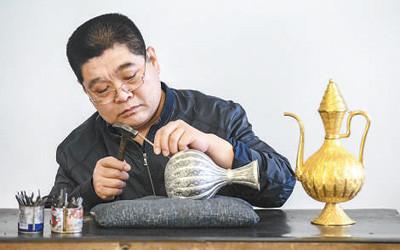
【Unique Highlights】
0.10mm! This is the finest filament diameter "pinched" by Ma Fuliang, the inheritor of the filigree inlay technique, and the highest level that this technique can achieve so far. Filigree inlay is a fusion art that integrates filigree, engraving, inlay and other crafts, and was included in the list of national intangible cultural heritage in 2008. Ma Fuliang is committed to combining traditional craftsmanship with modern technology, so that the ancient art of filigree inlay is integrated into people's daily lives and shines with new brilliance.
Pull out two silver wires, gently twist them together, place them on a washboard, and rub them back and forth with the board... The silver filament is as thin as a hair, only 0.10 mm in diameter, and the gap between the two silver filaments is continuously narrowed by the rubbing of the washboard until they are tightly intertwined. "We call more than two strands of silk filigree, and cloisonné is a single strand of flat silk, which is one of the differences between filigree inlay and cloisonné." Ma Fuliang (see picture, file photo) introduced to reporters while doing it.
After the silk rubbing is completed, it is the "breaking the flowers" link. Breaking flowers, that is, according to the drawing plan, use forceps to "break" the fine filaments into small filaments of different lengths and curves, and then gently stick to the carcass to form a complete shape and pattern. "The filigree process is particularly laborious. The completion of a work sometimes requires tens of meters or hundreds of meters of filigree, and the time consumption is often measured on a monthly basis or even on an annual basis. Ma Fuliang said.
The silver wire of 0.10 mm is the finest silk that Ma Fu Liang can "pinch" out, and it is also the finest filament diameter that can be achieved by the filigree inlay process so far. "In the past, the finest filigree could only be 0.13 mm." Ma Fuliang said, "It is not difficult to pinch the filament, the difficulty is how to weld these fine filaments together intact." "The finer the filament, the more difficult it is to control the welding fire. As long as the size of the welding fire and the position of the spray are slightly offset, it is easy to cause the filament to melt together with the solder, and the entire work will be abandoned. "Welding pays the most attention to the unity of hands, eyes and brain." Ma Fuliang said, "Brain control, eye staring, manual ... The eye captures the moment the solder is about to melt, and the welding fire in the hand must be evacuated in time and decisively. "Ma Fuliang also introduced a laser welding method, which is precisely welded by laser welding machines." Integrating modern technology into traditional crafts can promote the inheritance and innovation of traditional crafts and create more exquisite crafts. Ma Fuliang said.
"Filigree inlay is a fusion art that integrates filigree, engraving, inlaying and other processes." Ma Fuliang introduced that the history of Hebei Dachang filigree inlay production technology can be traced back to the Han Dynasty, with the development of history, the integration of multi-ethnic, multi-regional technical characteristics, the formation of unique filigree crafts. Nowadays, Dachang Hui Autonomous County has become the production and export base of filigree inlay handicrafts in the northern region of China. In 2008, filigree inlay making techniques were included in the national intangible cultural heritage list. In 2009, Ma Fuliang became the national representative inheritor of this project.
"The first time I made filigree crafts was at the age of 17." Ma Fuliang's father has been engaged in the production of filigree crafts. Under the influence of the ears, Ma Fuliang also slowly entered the industry. Among the many techniques of filigree inlaying, his favorite is engraving. "Don't look at just beating the hammer with a hammer, it's a lot of attention." The strength of the lower hammer and the angle of force must be continuously adjusted according to the thickness of the material and the undulating height of the pattern. In the engraving, the most troublesome is the hammer. "Three points of craftsmanship, seven points of guys." To get the finished product, guys have to do it. "Every time he makes a new work, Ma Fuliang always spends a lot of time researching the tools, making different shapes of hammers according to the pattern of the pattern. Over the years, Ma Fuliang has made and used nearly 400 hammers.
Exquisite jewelry, chic cup holders, gorgeous ornaments... "Only when the filigree inlay process is truly integrated into our daily life can it be passed on for a longer time and radiate a gorgeous brilliance for a longer time." "In the industry for more than 40 years, Ma Fuliang has never stopped innovating. Driven by him, Hebei Dachang filigree inlay product types have reached more than a thousand. In 2014, Ma Fuliang founded the Hebei Provincial Skills Master Studio. From 4 people at the beginning to 40 people today, 6 people in the studio have been rated as masters of arts and crafts in Hebei Province. "Traditional culture and national crafts are being loved by more and more people. I believe that with our perseverance, the ancient art of filigree inlay will surely shine with new brilliance. Ma Fuliang said.
Author: Shao Yuzi, a reporter of this newspaper
Source: People's Daily